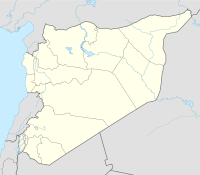Mureybet
| مريبط | |
| Location | Syria |
|---|---|
| Region | Raqqa Governorate |
| Coordinates | 36°02′36″N 38°07′43″E / 36.0434°N 38.1287°ECoordinates: 36°02′36″N 38°07′43″E / 36.0434°N 38.1287°E |
| Type | settlement |
| Width | 75 m (246 ft) |
| Height | 6 m (20 ft) |
| History | |
| Founded | 10,200 BC |
| Abandoned | 8,000 BC |
| Periods | Natufian, Pre-Pottery Neolithic A, Pre-Pottery Neolithic B |
| Site notes | |
| Excavation dates | 1964, 1965, 1971–1974 |
| Archaeologists | M. N. van Loon, J. Cauvin |
| Condition | flooded by Lake Assad |
| Public access | no |
Mureybet (Arabic: مريبط) is a tell, or ancient settlement mound, located on the west bank of the Euphrates in Raqqa Governorate, northern Syria. The site was excavated between 1964 and 1974 and has since disappeared under the rising waters of Lake Assad. Mureybet was occupied between 10,200 and 8,000 BC and is the eponymous type site for the Mureybetian culture, a subdivision of the Pre-Pottery Neolithic A (PPNA). In its early stages, Mureybet was a small village occupied by hunter-gatherers. Hunting was important and crops were first gathered and later cultivated, but they remained wild. During its final stages, domesticated animals were also present at the site.
The first archaeological investigation of the site was carried out in 1964. In that year, the site was noted during an archaeological survey of the region directed by Maurits N. van Loon of the Oriental Institute of the University of Chicago, and a small sounding was made. In 1965, a more extensive excavation was carried out, again under the direction of Van Loon. Between 1971 and 1974, work on the site was resumed by a team of the French Centre national de la recherche scientifique (CNRS) directed by Jacques Cauvin. All excavations were part of the larger international – and eventually UNESCO-coordinated – effort to investigate as many archaeological sites as possible in the area that would be flooded by Lake Assad, the reservoir of the Tabqa Dam, which was being built at that time. The filling of Lake Assad eventually led to the flooding of Mureybet in 1976. Although the site is now submerged and no longer accessible, the material that has been retrieved during the excavations continues to generate new research. This material is currently stored at the National Museum of Aleppo and the Institute de Préhistoire Orientale in Jalès-Berrias in France.
...
Wikipedia

